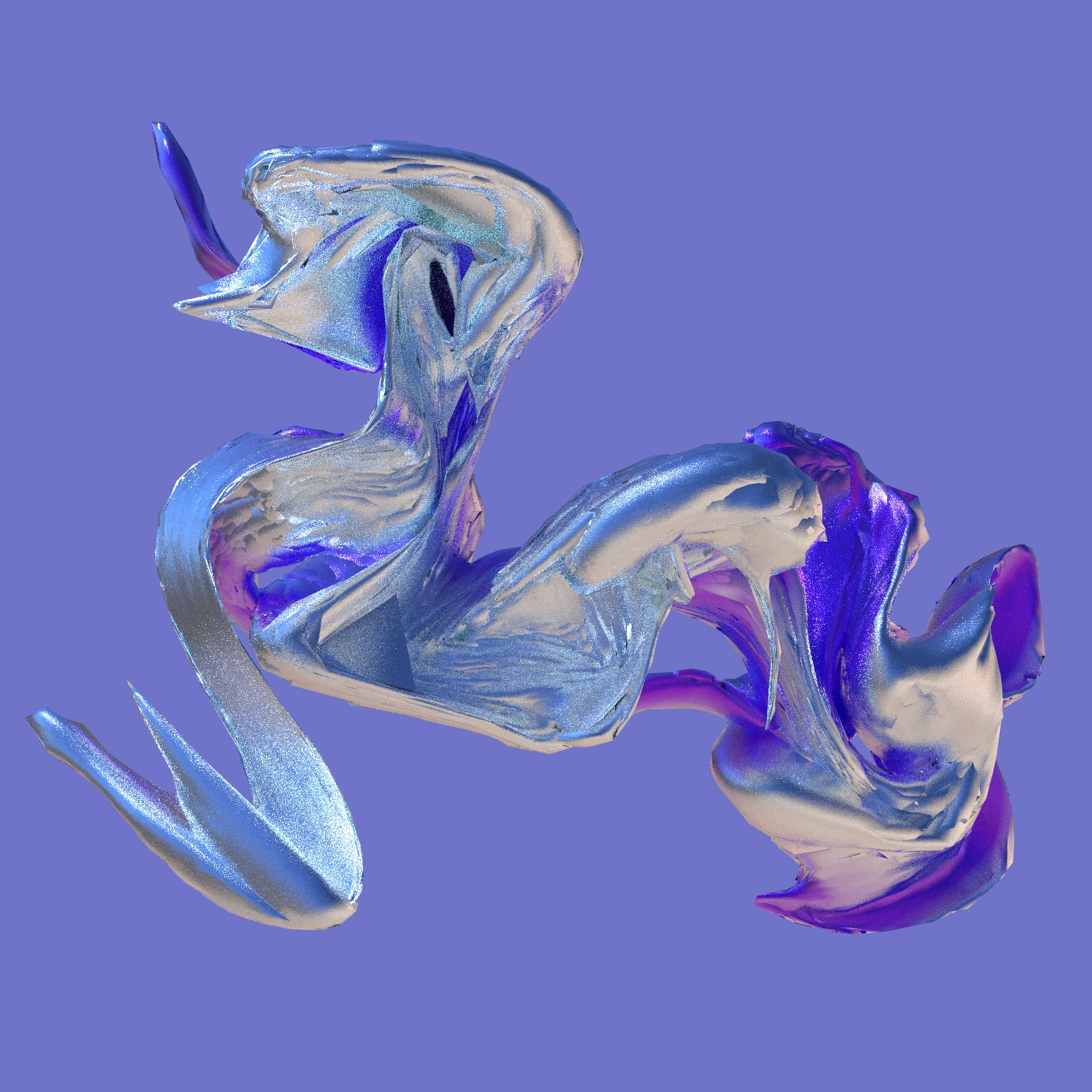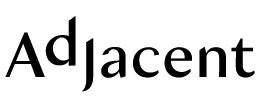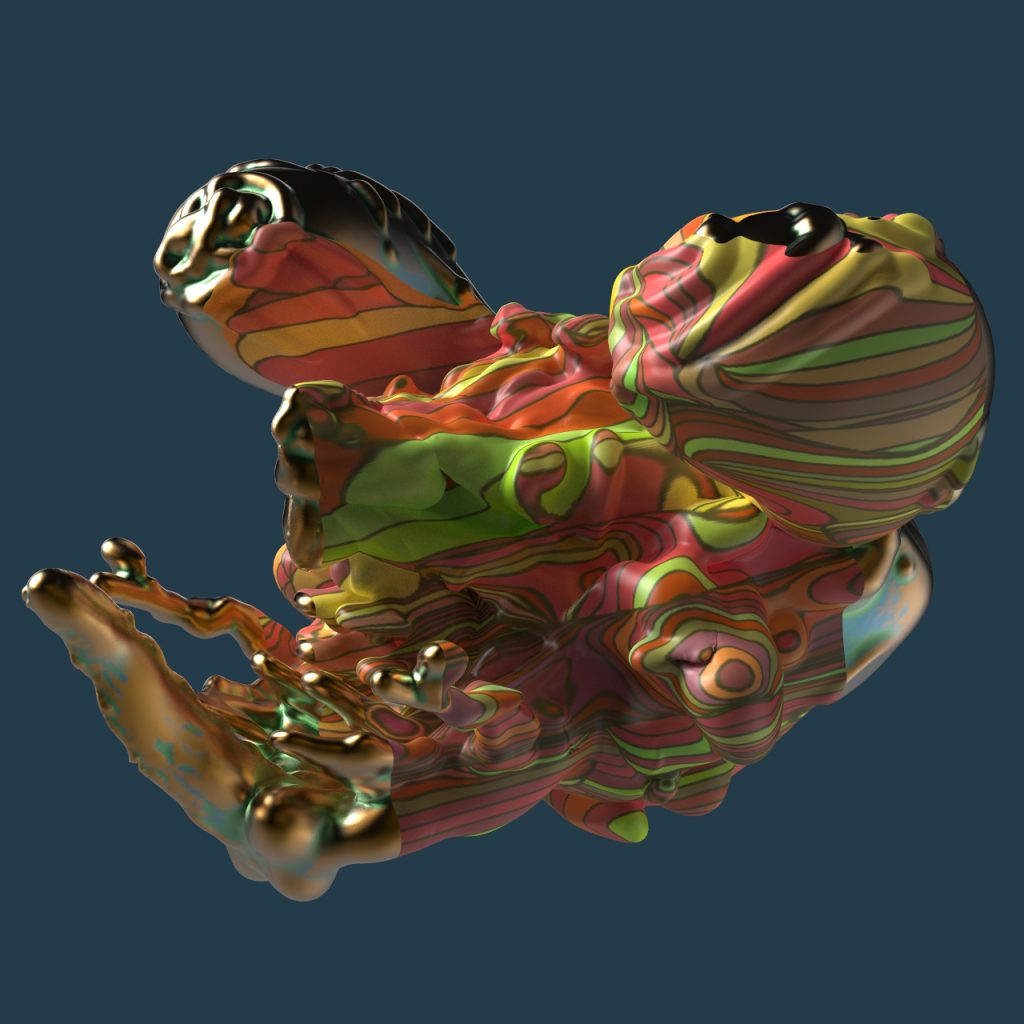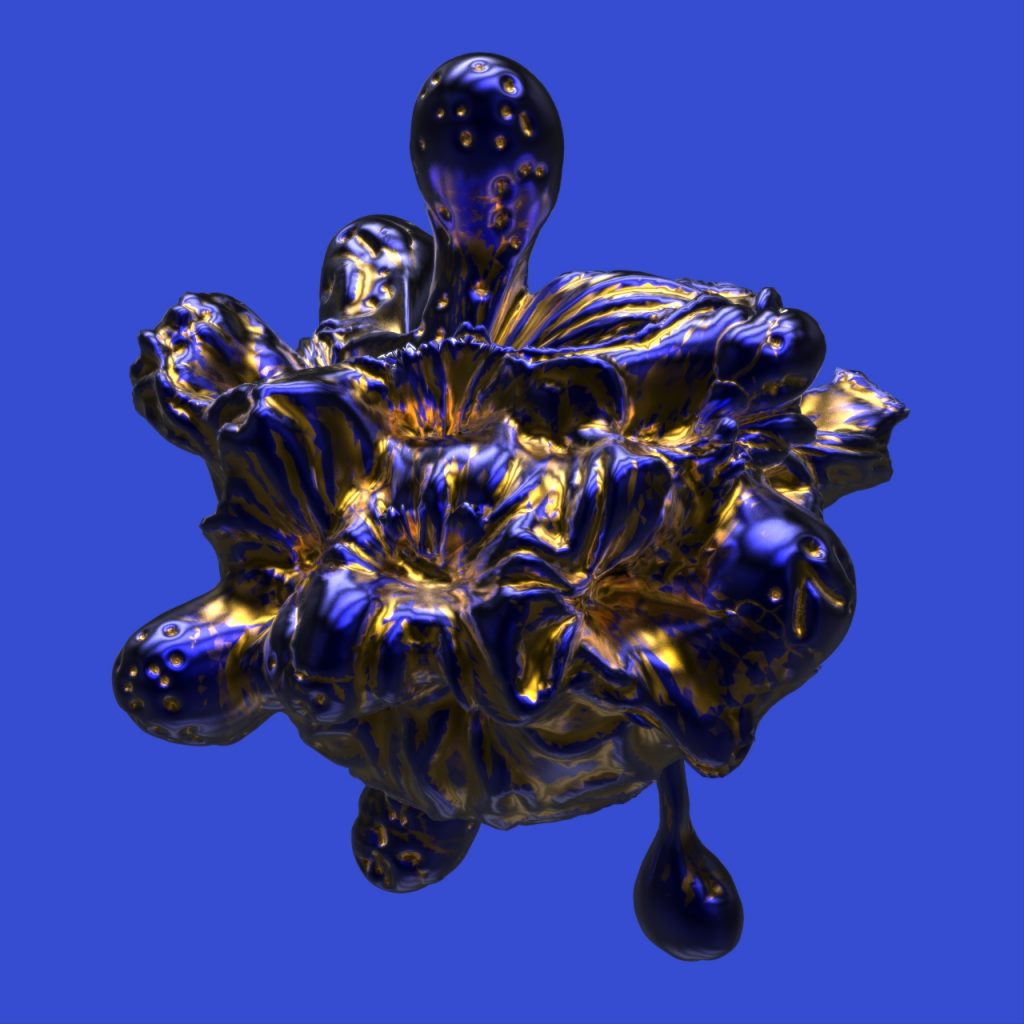Issue 5: Reality?
The Shape of Reality

The Shape of Reality
By Kathryn Zazenski
Illustrated by Chengtao Yi
Revisiting the definition of reality and the flexibility of its shapes during a time of insecurity. Perception is learned—spatially, culturally, psychologically— narrative is directed, truth has never existed at just one point in space.
In 2004, science-fiction writer Ursula K. Le Guin wrote a short piece in response to an assertion that she avoided technology and instead wrote “soft science fiction.”(1) Le Guin railed against this accusation, defining technology not as “wires and servers,” but rather as how society responds to physical reality. More recently, I was thinking about the flexibility and subjectivity of reality after coming across the work of Hilma af Klint, an early 20th-century painter who has only recently gained attention for her revolutionary works. Her paintings, many of which were realized through spiritual divination, share this sense of the truer definition of technology, this response to lived reality.
Originating in the early 17th century, the term “technology” referred to the systematic treatment of art, craft, and technique related to making or doing(2). The concept of technology has always had strong relationship to the hand, to the human body, to the life process. It wasn’t until the tail end of the 20th century that we began equating technology almost exclusively with the computers and devices that we live with and use. In fact, the term “digital” has a similar corporeal relationship, being coined even earlier, in the 15th century, and referring to a finger or a toe—a digit(3). In this short span of about thirty years, we’ve almost all but eliminated the history, the diversity, and the physical connection to the body that both of these contemporary definitions all but deny.
We often lose sight of the flexibility of both form and narrative, especially during times of great insecurity, be it political, economic, climate-related, or other. We tend to seek stability and order, something to give structure and form to an otherwise nebulous-seeming existence. Theoretically, when the threat wanes, form and narrative return to this state of being elastic and encompassing. But what happens when change is experienced at a pace and scale previously unknown, when insecurity isn’t an aberration but rather the norm? What happens when we no longer know how to interpret our fight-or-flight alarms or simply how to be empathetic towards one another? What tends to happen is that the reins never loosen and the boxes become rigid and brittle. Our muscles are flexed and poised so tightly, braced for impact, that they break under their own pressure before they succumb to any type of external force.
So why do we enact such tensions? Because within them is temporary relief. We edit histories, we redefine and re-shape narratives, we narrow the field of vision. We are constantly working to place and to describe, to name, to give a solid edge to; to know in a way that feels comfortable, in a way that feels safe and secure and tangible. It is a way to draw a clear line between truth and fiction, the real and the surreal; it is the newer, external way to form knowing. But, as history has proven time and time again, just because we can’t see something, or don’t yet know how to measure it, does not mean it isn’t in fact real.
In early November I made my second visit to see Hilma af Klint’s exhibition Paintings for the Future at the Solomon R. Guggenheim Museum. af Klint (1862-1944), a proponent of theosophy, a spiritualist, a scientist, and an artist, created hundreds of works in her lifetime, but left explicit instructions for them to be insulated from public viewing for 20 years after her death. Af Klint remained a hidden figure until very recently(4), only now occupying the space and critical discourse that was denied to her work for so long. Her resistance to sharing her paintings posthumously was not for lack of confidence, but rather came from a space of knowing that the then-contemporary world did not have the capacity to fully comprehend the works(5), many of which were divined through spiritual meetings. Beginning in 1896, af Klint and four other women, known as “The Five,” conducted meetings wherein they received messages from spiritual beings referred to as the “High Ones.” It is through these communications that the 193 works in the series Paintings for the Temple were commissioned(6).
Victorian ether physics, the x-ray, and radioactivity were some of the late 19th- and early 20th-century revelations that profoundly affected human conceptions of how the world fundamentally works. For many artists working in Russia, Europe, and the US, these new ideas invariably brought to the surface questions about the role of the human within this system, and became tools for exploring similarly ethereal concepts in physics, like the relationship between time and space, not only conceptually, but aesthetically(7). These discoveries provided a link between physics and spirituality, which became associated with the fourth dimension (time). A simultaneous rise in fascination with nature, return to spirituality, and focus on rationality and organization of the physical world inspired ideas about “cosmic consciousness” for artists such as Kazimir Malevich, Mikhail Matyushin, and Hilma af Klint. This was a turn towards philosophies of life that supported ideas of interconnectedness and the balance between the rational and spiritual minds, embracing the notion that life existed beyond purely chemical and mechanical processes(8).
While observing af Klint’s work at the Guggenheim, I overheard a docent talking with her tour group about some of the principles explored in the pieces. We stood somewhere around the fourth level, amidst a series of paintings titled SUW/UW that featured patterns of bullseye-like rings, a target of concentric circles divided in half down their north/south axis, with striking colors like red, black and white balanced by counterpoints of soft blue, pink and yellow. The guide was in the middle of a narrative about binaries, the points in these paintings where opposites meet one another—the moment where black meets white, blue meets yellow, hard line meets curved line, light meets dark, above meets below. In the museum that day, standing in front of four pieces in particular: The Swan, No. 17, No. 16, and No. 1 Starting Picture(9), and listening to this narrative unfold, I began to see the primary site as that liminal space between borders, where the two halves of the binaries meet. I began to realize that this space between is this critical space of reality. It is the border of the binary, the boundary that separates, that not only defines one from other but synchronously forces interaction, which in turn forces recognition and awareness. It is in some ways a simultaneous solid and liquid, wall and window.
In af Klint’s paintings, the edges are clear. In a traditional binary system, edges are clear. Bad is not good, and white is not black. Edges make us feel comfortable, help us know how to categorize and order things, how each piece fits in the system. In that moment of conscious acknowledgement of the edge, I began to think about the edges of the human body, and the increasing blurriness of this bounded, familiar space. Information and interaction today tends to come at us with an abstracted sense of place and time, primarily through the interface of a screen. The tools that organize and know for us, entertain us and bring the universe into our most intimate spaces, are redefining this connection to the physical body. As a sculptor, I have been trained to consciously consider material, spatial, theoretical, and conceptual relationships. Every object or idea, place, body, tool, and space carries myriad narratives based on culture, history, landscape, political orientation, economic strata; everything has a basic context and exists within a basic construct. And I know that when information is processed without consciousness of form or context, when abstraction is accepted as reality, we lose the ability to consider nuance, dimensionality, fluidity, and the ability to depict more than one narrative and have it be true. Perhaps it is this inability to recognize the borders and boundaries of our own physical bodies that is leading to the rigidity and insecurity, and our impulse to divide and protect that exists in every corner of contemporary life. If we consider the possibility of this subconscious disembodiment, how do we breed dimensionality back into our spaces and ideas, and how do we reconnect within to redefine the edges of the self? We still have opposable thumbs for a reason, articulated joints, a sense of smell and taste. The biological evolutionary process has not been able to meet the rate of change that the pace, models, tools, and patterns of contemporary life demand. The body processes untold amounts of information throughout the day that informs absolutely everything we do, consciously or otherwise. Perception is learned—spatially, culturally, psychologically— narrative is directed, truth has never existed at just one point in space.
So the thing is, there is no solid, there is no fixed point or place or perspective. The only thing we can rely on consistently in these increasingly foreign spaces is our physical body. It is all shaped and defined by what it is butting up against, by the infinite frames and edges and borders that position inside and outside, public and private, self and other, to infinitude. It is a very clear, discrete, ever-defined edge; one that is flexible and accommodating to shifts in culture, time, norms, values, and space. And when under pressure, the shapes do not break but rather heave. This borderline becomes a shared site of pushing and pulling, an attempt to claim power, but ultimately, in undefined time, settle in equilibrium. And instead of relying on the binary as the foundation, it is allowed to stretch into space and become a value scale of dimension, rife with borders, edges, and boundaries that accommodate all possible nuances and iterations in both time and space, not simply defined by what it is not. But this is not an either/or situation; there is room for the physical body to be present in these contexts. As Rosalind Krauss notes in her 1979 essay “Sculpture in the Expanded Field,” there are structures that straddle, or occupy multiple forms—the labyrinth, or Japanese garden, is both landscape and architecture(10).
X-ray imaging, discovered by physicist Wilhelm Röntgen in 1895, yields a physical image with equal parts structure and flow; it is the oppressor and the liberator, betraying the shapes and shadows of our most intimate, hidden spaces(11). Smoke-like, nebular, ethereal masses envisioned in tones of blue and gray through density—they are bounded and fluid, echoing the depths of the blackest ocean or farthest galaxy. X-rays represent a space that is both elusive and concrete, public and private. They are a negotiation between the real and the perceived, between the rumor and the proof.
Our new way of existing in the world, primarily through screens, definitely has its advantages—we can “know” more than we ever have before, we can experiment with identity, with these more traditional borders and boundaries, and build new configurations and structures. But this should not come at the cost of our knowledge of the embodied self. Life is rather nested like a matryoshka: the rhythms and bounded spaces of birth, maturation, and death. The patterns and shapes of institutions like politics, society, education, and care overlap in ways that reflect changes in law or zeitgeist, are stacked by importance, which is itself a shape, an imposed hierarchical structure. These skins overlay one after the other like transparencies, always fully exposed but not always fully able to be conceptualized because of what sits below and above. The surface is both site and receiver. It contains both rigid form and fluid skin. When we forget the critical nature of the total body experience, the result is automatic flattening. We learn to accept the flattened, simplified, abstracted experience as the standard for all experience. We accept this and then build on top of it, further and further alienated from the physicality, and then instead of engaging our bodies as tools, we drag them around as messy vehicles, secondary to the abstract, non-physical world. How do we reconcile these changes, not only in terms of future functionality, but also as processing agents for perception, for memory, for historical time and space?
There is a striking visual relationship between recent images of James Turrell’s 60-plus-year project Roden Crater, certain works by af Klint, particularly Altarpiece, nº1 (1915), and the Plac Wilsona station on the Warsaw M1 metro line, designed by Polish architect Andrzej Marek Chołdzyński. Pyramidal forms receding backward into space being met toward the upper two thirds of each form with a circular or oval void/color-field, these shapes and spaces echoing one another from completely different terrestrial timelines. Two are physical spaces, and one is an illustration of a vision received. Forms and ideas are repeated in time and space. Images are created, questions asked, conversations had, all circling around one another, never able to be fully attained, answered, or resolved. We look, question, search, and tell in patterns that shift according to cultural, temporal forms, but these impulses are in fact eternal. And what is this link between them? Perhaps nothing more than the occupation of a physical form, a physical body, the embodied experience. It is perhaps the only element that cannot be divided by culture, geography, economy, or time. So long as the human condition remains linked to the physical form of the body/mind continuum, we remain linked to these impulses, these somatic forms. Form corresponds to dimensionality in the way Edwin Abbott Abbott described in his 1884 novel Flatland(12), in which two-dimensional shapes were incapable of conceptualizing the three-dimensional characters looking down upon them. Life is forwards and backwards, left and right. There is no up or down, over or under, when we have no way to perceive, to receive, to conceptualize it. There is only this body, this concept of time and space.
Reality is the recognition of these bounded constructs, and an acknowledgement that most of the world as we know it is actually good and bad, true and false, known and unknown. Technology is not only programs and gear; it is the myriad ways in which we respond to reality. It is the structures and constructs—the tools and languages and shelters and ideas and ethical codes and cultures and hybrids and modifications and intelligence. It is in the observation of these responses, through critique and questioning, through the information that we perceive and receive of the embodied experience that we then refine and expand and move through designated time and space. The shape of reality is faith in the boundary: a re-expansion of dimensionality, of nuance, of time. It is a refusal to accept myopic distillations of complex, nuanced systems and is both fluid and structural. It is the reconnection to the self and the recognition of the edges that exist between the I and the you. In the words of af Klint, “everything is unity.”
1. Le Guin, Ursula K. A Rant About “Technology” 2004
2. Technology (n.). (n.d.). Retrieved from https://www.etymonline.com/word/technology
3. Word trends: Digital. (2016, March 10). Retrieved from https://blog.oxforddictionaries.com/2012/03/06/word-trends-digital/
4. Af Klint’s work was first shown posthumously in the 1986 exhibition “The Spiritual in Art, Abstract Painting 1890–1985” at the Los Angeles County Museum of Art, curated by Maurice Tuchman.
5. Julia Voss, “5 Things One Should Know About the Life of Hilma Af Klint,” (Lecture notes, The Solomon R. Guggenheim Museum, October 12, 2018).
6. About Hilma af Klint -. (n.d.). Retrieved from https://www.hilmaafklint.se/about-hilma-af-klint/
7. Aleksandra Jach and Paulina Kurc-Maj, Superorganism: The Avant-Garde and the Experience of Nature (Łódź: Muzeum Sztuki, 2017), 100
8. Jach and Kurc-Maj, 100, 102
9. Group IX/SUW, The Swan, No. 17 (Grupp IX/SUW, Svanen, nr 17), from The SUW/UW Series (Serie SUW/UW), 1915and No. 1 Starting Picture, 1920
10. Krauss, Rosalind. “Sculpture in the Expanded Field.” October, vol. 8, 1979, p. 30.
11. Colomina, B. (2016). X-Screens: Röntgen Architecture. The Printed and the Built. doi:10.5040/9781350038387.ch-006
12. Abbott, Edwin Abbott. Flatland. Seeley & Co, 1884
Kathryn Zazenski is a visual artist who explores the malleability of perception and connection through art-making, writing, lecturing, and community building. Zazenski has participated in international artist residencies and has exhibited her work internationally at institutions such as the San Diego Art Institute (CA), the Zachęta National Gallery of Art (PL), and the Center’s for Contemporary Art in Warsaw and Vilnius. Zazenski received her MFA in Sculpture from the Cranbrook Academy of Art and is a two-time Fulbright Fellow to Poland, where she is co-director of Stroboskop Art Space and creator of The Haptic Mind. Zazenski currently lives between the US and Poland. | kathrynzazenski.com


